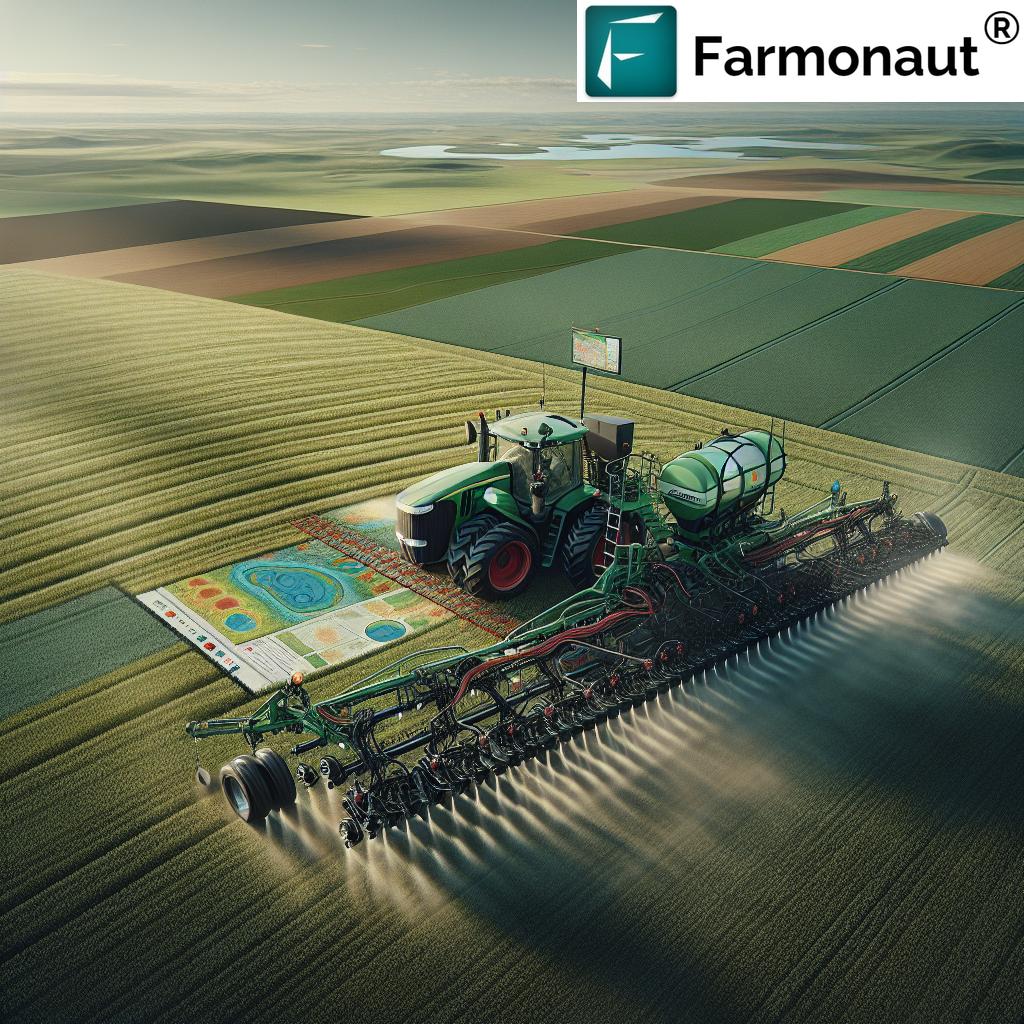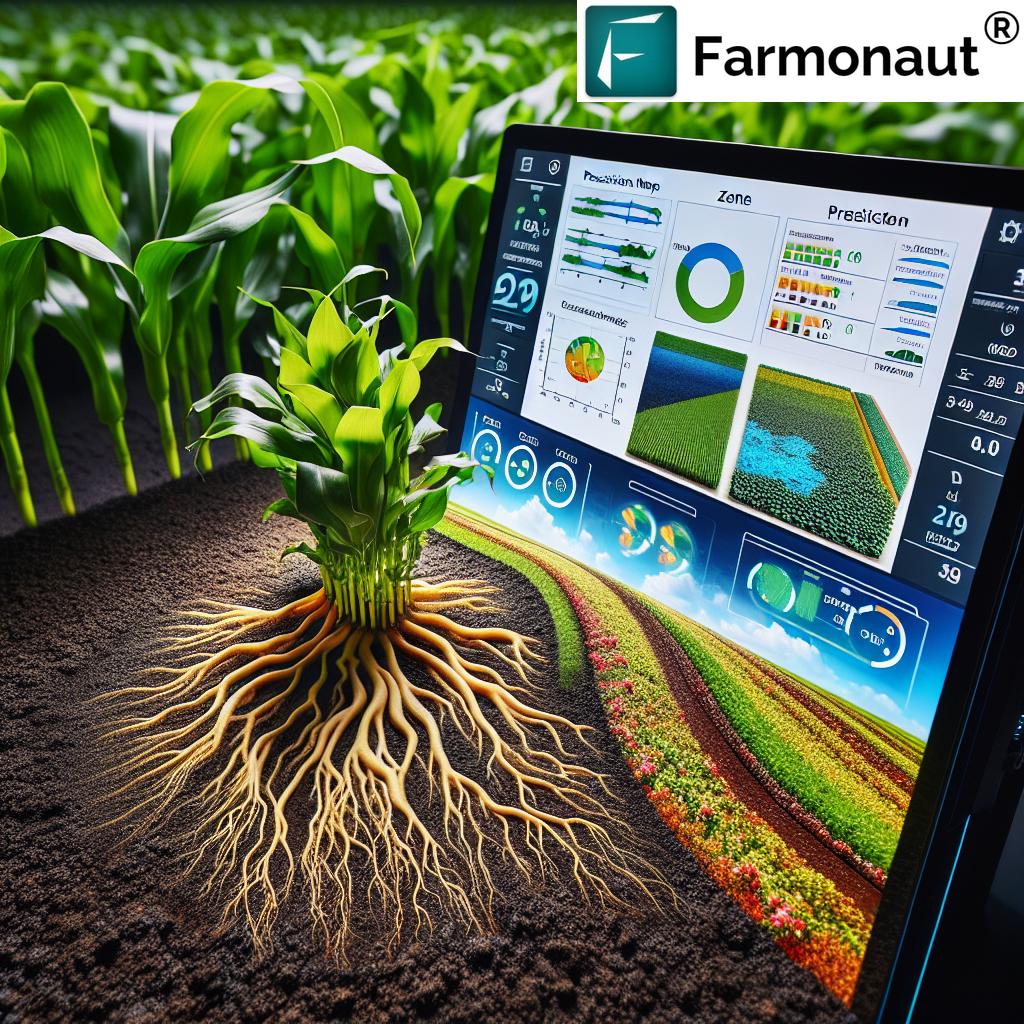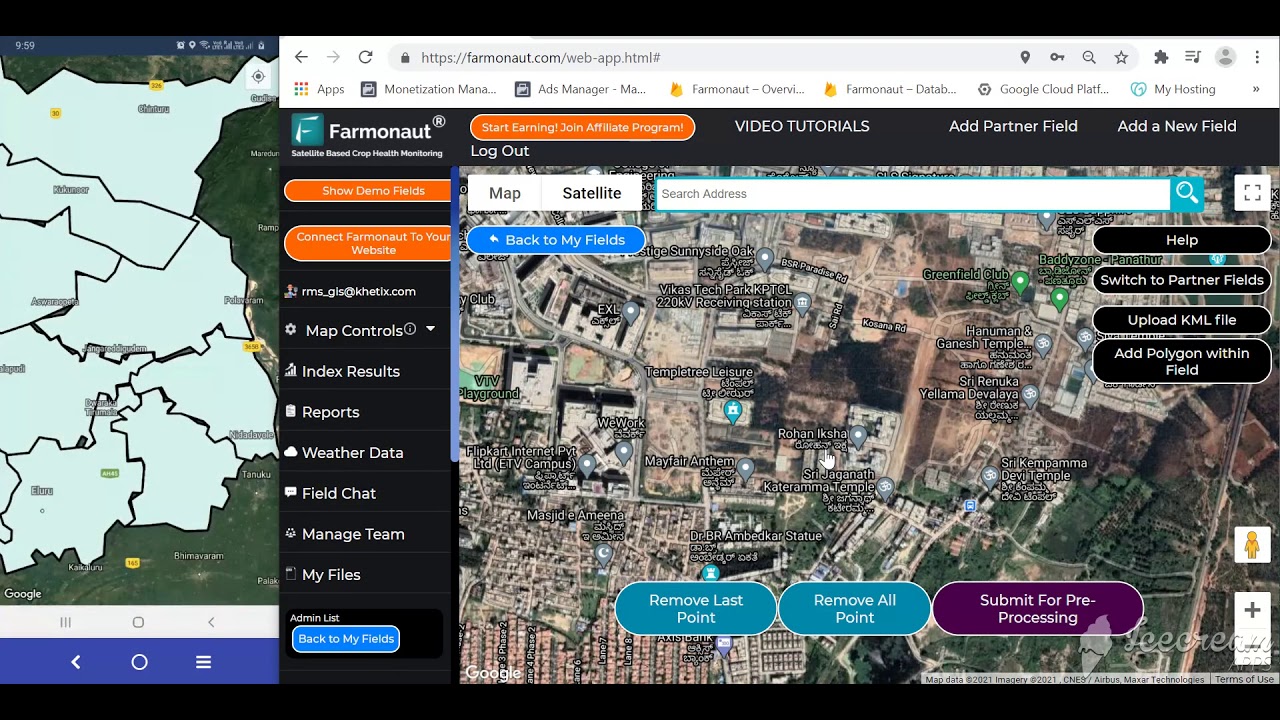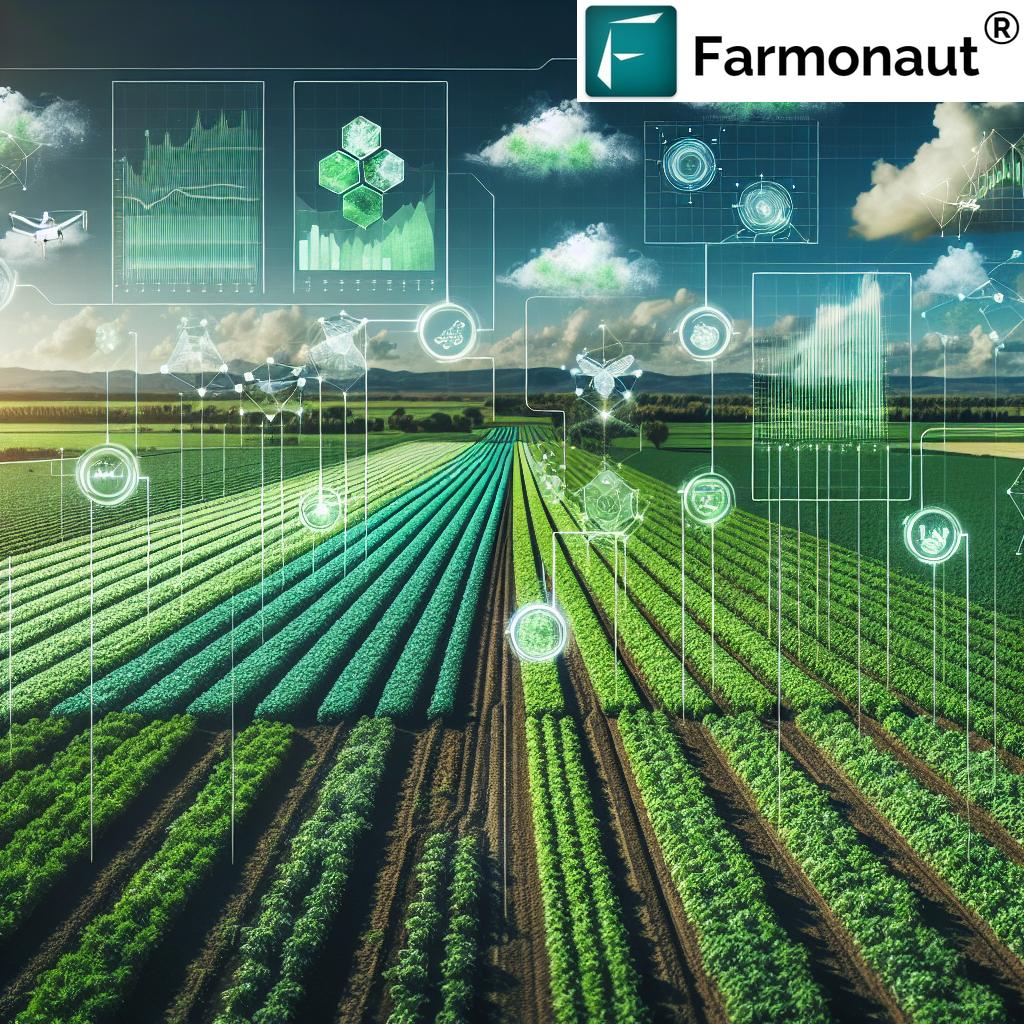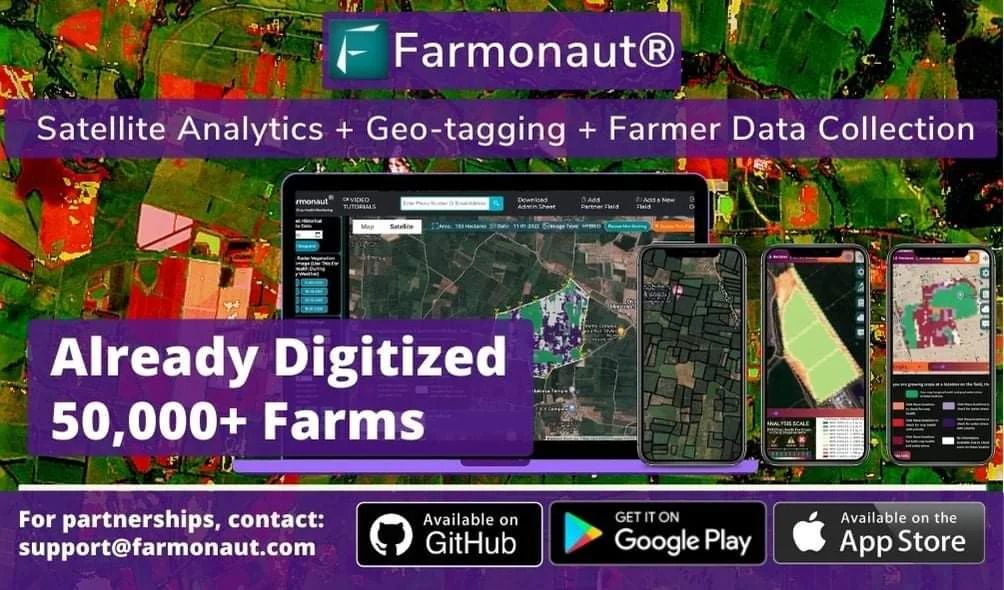How Variable Rate Fertilizer Boosts Yield & Profits: Precision Agriculture’s High-Tech Pathway to Sustainable Success
Meta Description: Variable rate fertilizer application (VRFA) is transforming how we farm—discover how this precision agriculture solution optimizes crop yields, reduces fertilizer costs, and boosts sustainable farm profitability.
“Variable rate fertilizer can reduce input costs by up to 20% while increasing crop yields by 10% in precision agriculture.”
1. Introduction: The VRFA Revolution
Imagine every part of your field getting the precise amount of nutrients it needs—no waste, no shortage, only optimal growth and sustainability. Variable rate fertilizer application (VRFA) is more than a buzzword; it’s a cornerstone of precision agriculture solutions that’s reshaping the future of farming in regions like Western Canada, Ohio, and everywhere precision matters. With VRFA, we no longer treat our fields as uniform; we recognize and act upon their variability for optimizing crop yields and maximizing profitability.
This technology-driven approach empowers us, as farmers and agri-professionals, to make smarter choices, reduce fertilizer costs, enhance sustainable farm profitability, and play a part in environmental preservation. Throughout this blog, we will dive deep into the science, strategy, and real-world impact of variable rate fertilizer application. Let’s explore the journey to higher yields, efficient fertilizer use, and sustainable practices—powered by innovations like Farmonaut.
“Precision agriculture technologies have improved fertilizer use efficiency by 15-25% on average, boosting sustainable farm profitability.”
2. Understanding Variable Rate Fertilizer Application (VRFA)
Let’s break down why variable rate fertilizer application has become a cornerstone of precision agriculture across diverse landscapes—from the rich, loamy fields of Ohio to the vast prairies of Western Canada. Traditional farming methods often treat each field as homogenous, applying uniform fertilizer rates across the entire area. However, we know from experience and data collection that, within a single farm, soil properties, nutrient requirements, and yield potential can vary greatly.
What Is VRFA?
VRFA enables us to divide our fields into management zones based on specific characteristics such as soil type, nutrient levels, and historical production data. Instead of a “one-size-fits-all” approach, we use tailored fertilizer application. This means applying fertilizers at varying rates—directly optimizing nutrient utilization for every crop or zone. With advanced fertilizer application technology—like GPS-driven applicators, prescription maps, and satellite-guided variable rate systems—we can take our soil nutrient management to the next level.
Why Do Fields Need Variable Rates?
- Soil fertility isn’t uniform: Nutrient levels and organic matter shift due to factors like crop rotation history, drainage, topography, and prior yield records.
- Crops have specific needs: Different zones may host different crops, varieties, or experience microclimates that affect nutrient uptake.
- Precision = Efficiency: By applying the right amount of fertilizer in the right place at the right time, we maximize crop health (plants receive optimal nutrients), minimize input wastage, and reduce costs.
Cornerstones of VRFA Implementation
- Data Collection & Analysis—Combine soil sampling with historical yield monitoring and remote sensing data to identify patterns and varied field zones.
- Prescription Mapping—Create digital zone-based fertilizer application prescriptions for each area, using inputs like soil pH, moisture, and crop-specific requirements.
- Application & Monitoring—Leverage variable rate applicators equipped with GPS technology for precise, real-time application, continuously monitoring crop response for in-season adjustments.
This precision innovation in agriculture is now within reach for farms of all sizes, thanks to platforms like Farmonaut that provide API access to satellite and weather data—a truly scalable and affordable path to precision nutrient management.
Key Terms in VRFA:
- Management Zone: A sub-field area defined by similar soil, yield, or terrain characteristics.
- Prescription Map: Digital instructions for fertilizer rates per zone—uploaded to the applicator’s display or controller.
- Variable Rate Applicator: Equipment that automatically adjusts fertilizer application rates based on GPS mapping and prescription data.
- Efficient Utilization: The process of matching input application to plant uptake, reducing excess and deficit zones.
3. Variable Rate Fertilizer and Enhancing Crop Yields
One of the top reasons we adopt precision agriculture solutions like VRFA is to boost crop yields. Our fields are diverse—nutrient requirements, organic matter, and water-holding capacity differ every few meters. By leveraging data-driven approaches, we can optimize crop yields in each zone and maximize overall production.
How Does VRFA Improve Yields?
- Optimal Nutrient Distribution: With variable rate applications, every plant receives just what it needs to thrive across the growing season.
- Mitigating Yield-Limiting Factors: Under- or over-fertilization impedes plant health; with VRFA, we reduce both risks dramatically.
- Enhanced Crop Potential: Studies in Western Canada have shown up to a 50% increase in total crop production over ten years by adopting VRFA; fields in Minnesota reported a 17% bump in average corn yields compared to uniform fertilization.
Turning Data into Yield Potential
With each season, we collect data through satellite imagery platforms like Farmonaut, leveraging indicators such as NDVI (Normalized Difference Vegetation Index), soil moisture, and past crop outcomes. These insights drive smarter, evidence-backed fertilizer application prescriptions. The result? Plants receive optimal nutrition, ensuring a higher likelihood of robust, healthy, and profitable yields.
VRFA’s outcome is not just a marginal improvement but a fundamental shift—fields that were once limited by a blanket application now reach their full potential, one management zone at a time.
4. Boosting Farm Profits and Reducing Fertilizer Costs
Profitability lies at the heart of every modern farm business. While increased yields are vital, reducing input costs—especially fertilizer expenditures—is equally critical. VRFA empowers us to address both, bringing measurable business benefits directly to our bottom line.
How VRFA Reduces Input Costs
- Application Efficiency: By only applying the amount of fertilizer needed in each zone, we see reductions in overall fertilizer use by up to 20%. This translates to serious dollar savings per hectare or acre, especially on large-scale operations.
- Reduced Over-Application: Uniform application can lead to nutrient excess in some zones, which not only raises costs but risks environmental penalties. VRFA mitigates these risks.
- Optimized Crop Quality: Better nutrient management delivers not only more harvest but higher-quality output, leading to premium market pricing.
ROI Examples: Where the Money is Made
- Ohio Studies: In no-till fields, cost savings between $36 and $88 per acre were observed compared to traditional methods. Cost reductions come from decreased fertilizer and lime use, with consistent or superior yields.
- Profit Increase: Implementing VRFA often results in double-digit percentage increases in average profit—by maximizing input efficiency and minimizing waste.
Beyond Fertilizer: Downstream Economic Benefits
- Optimized Labor and Machinery Use: By targeting field zones, we minimize unnecessary field passes, guide efficient fleet management, and lower fuel and repair costs.
- Reduced Crop Losses: Healthier plants and higher-quality yields mean fewer losses and less need for reactive interventions like rescue fertilization or extra pest control.
- Integration with Digital Tools: Leveraging fleet management tools (e.g., Farmonaut’s solution) helps us synchronize VRFA with machinery logistics, amplifying cost and time savings.
Real-time crop health monitoring and AI-based advisory systems like Jeevn AI from Farmonaut amplify the economic benefits of precision nutrient management by ensuring that every dollar spent brings measurable yield and profit improvements.
5. Environmental Benefits of Precision Farming and Sustainable Practices
Agriculture is at the heart of the sustainability conversation. With VRFA, we’re not just maximizing crop yields—we’re actively reducing agriculture’s environmental footprint through smarter soil nutrient management and resource optimization.
How VRFA Drives Environmental Stewardship
- Reduced Nutrient Runoff and Leaching: By precisely applying nutrients where and when they’re needed, we minimize the loss of fertilizers into groundwater and nearby water bodies.
- Healthier Soils: Over-fertilization leads to soil acidification, disrupts beneficial microbial communities, and can cause long-term fertility loss. VRFA preserves soil health for sustainable, ongoing production.
- Carbon Footprinting: Platforms like Farmonaut make it easy for us to track and reduce emissions, generate real-time carbon data, and move toward compliance with net-zero agriculture policies.
- Efficient Use of Resources: Water, energy, and fertilizer are all conserved with targeted zone-based applications.
- Regulatory Compliance: Meeting or exceeding environmental standards not only protects our land and community—it opens up new markets for sustainably grown products.
Environmental Impact Snapshot (Research Summary):
- Illinois field trials: Zone-based nitrogen and pH management netted up to $25,000 in additional profits while cutting nutrient loss.
- Global review: Studies show fertilizer use efficiency increases 15-25% with precision farming technologies, translating to less runoff and improved soil fertility over time.
- Integration: Using blockchain-based traceability from Farmonaut also supports verifiable supply chains, enhancing both transparency and sustainability.
Together, these steps set the stage for sustainable farming practices—balancing productivity, profit, and environmental responsibility in every field, every season.
6. Implementing Variable Rate Fertilizer Application: Steps Toward Success
A variable, data-driven approach to fertilizer use is within reach for all farms. Here’s a step-by-step guide on implementing VRFA effectively in your operation:
Step 1: Detailed Data Collection
- Gather soil samples from each field zone to determine baseline fertility and chemical properties like pH, organic matter, and nutrient levels.
- Tap into historical yield data and satellite-based crop monitoring (e.g., via Farmonaut’s API or apps) for granular, year-over-year trend tracking.
- Include terrain features—elevation, slope, and drainage—that may affect crop yield potential.
Step 2: Field Mapping with GPS and Remote Sensing
- Use digital apps or mapping tools to create prescription maps detailing management zones.
- Efficiently visualize and edit zone boundaries using solutions such as Farmonaut’s Large Scale Farm Management platform, designed to streamline GPS-based field mapping.
Step 3: Prescription Development
- Develop customized fertilizer application prescriptions—specific fertilizer type and rate for each zone, based on the synthesized field data.
- Utilize AI-driven advisories (like Farmonaut’s Jeevn AI) for extra refinement and real-time adjustments throughout the season.
Step 4: Precision Application
- Deploy variable rate applicators compatible with GPS prescription files. These machines adjust rates “on the go” as they cross each management zone.
- Use connectivity tools (web, API, or mobile) to record actual fertilizer use, enhancing traceability and auditing. Explore Farmonaut’s satellite-based verification for crop loans and insurance support.
Step 5: Continuous Monitoring and Adjustment
- Monitor crop response in real time using satellite imagery and field scouting.
- Adjust prescriptions as new data emerges (e.g., in-season weather changes, unexpected pest or disease outbreaks).
- Archive performance metrics to refine next year’s management zones and fertilizer rates.
By implementing this workflow, we ensure that every input dollar is accounted for—and every kilogram of fertilizer delivers optimal value by reducing fertilizer costs and promoting sustainability.
7. Comparative Impact Analysis: Conventional vs. Variable Rate Fertilizer Application
To truly appreciate the benefits of variable rate fertilizer application, it’s helpful to compare its impact with traditional, uniform application methods. See the table below (based on estimated values from industry benchmarks and studies in Western Canada, Ohio, and beyond).
*(Estimates: Industry averages. Actual results vary by region, crop, historical management, and precision technology used.)*
Key Takeaway
VRFA outperforms conventional application across all critical performance metrics—yield, profit, input savings, and environmental stewardship. The advantages compound season after season as more refined data leads to smarter prescriptions and wiser resource allocation.
8. Farmonaut: Making Precision Agriculture Accessible
The biggest challenge for small and medium-sized farmers globally has often been access to cost-effective, user-friendly precision agriculture technologies. Farmonaut—pioneering satellite-based farm management via Android, iOS, and web—breaks these barriers through affordable subscriptions, flexible API integration, and robust, AI-powered insights.
- Real-time Crop Health Monitoring: With multispectral satellite imagery, we proactively track vegetation health (NDVI), soil moisture, and pinpoint anomalies—enabling immediate precision interventions.
- AI-Based Advisory: Farmonaut’s Jeevn AI delivers customized, in-season recommendations, helping optimize fertilizer rates and timings for every management zone.
- Resource Management: From fleet and operations to carbon emissions, Farmonaut centralizes logistics, auditing, and sustainability tracking across the entire agricultural cycle.
- Transparency and Traceability: Farmonaut’s blockchain-based solutions guarantee the provenance of your harvest—building market trust through verified sustainable practices.
Bottom Line: Farmonaut makes precision farming affordable for everyone, from individual farmers to government bodies and corporate clients, all without requiring expensive on-farm hardware or technical expertise.
9. Challenges, Solutions & Future Trends in VRFA
While the advantages of variable rate fertilizer application are compelling, implementing VRFA isn’t without its challenges—especially for first-time users or in regions where digital agriculture is still emerging.
Common Challenges
- Upfront Investment: Equipment such as variable-rate-capable applicators and GPS systems represent capital costs—but these are rapidly falling.
- Data Collection and Interpretation: Quality, high-resolution data are vital. Missteps in mapping or sampling can create costly prescription errors.
- Field Variability Complexity: Natural field complexity requires continuous monitoring and regular adjustment of management zones and rates.
- Lack of Technical Skill: Some farmers may feel overwhelmed by new software or analytical tools; however, user-friendly interfaces (like those from Farmonaut) are solving this issue fast.
How We Can Overcome These:
- Leverage Affordable, Scalable Services: Farmonaut delivers satellite-based, easy-to-use crop and soil monitoring—no in-field sensors required. This lowers the barrier to precision and boosts accessibility worldwide.
- API and App Access: Farmonaut’s API and Developer Docs make it seamless for agribusiness, government, or tech partners to integrate advanced field and climate insights.
- Education and Training: Expand your team’s knowledge with online support, platform tutorials, and real-time advisory like the ones provided in Farmonaut’s app ecosystem.
Looking Ahead: The Future of VRFA
- Real-Time Adaptive Prescriptions: With IoT and continuous satellite monitoring, VRFA will become even more dynamic, responsive to hyperlocal weather or crop stress signals.
- Integration with Financial Services: Insurance, traceability, and credit risk assessment will increasingly rely on digital field histories and application logs.
- Scaling Sustainability: As carbon emission tracking becomes standard (via tools like Farmonaut’s carbon footprinting solution), VRFA will support compliance and incentivize best practices worldwide.
10. Frequently Asked Questions (FAQs)
Q1: What is variable rate fertilizer application (VRFA)?
A: VRFA is a data-driven approach where fertilizer is applied at varying rates across a field, targeting the specific needs of each management zone based on soil, crop, and yield data. This method ensures optimal nutrient use and maximizes crop yields while minimizing costs and environmental impacts.
Q2: How does VRFA benefit small and medium farms?
A: Affordable solutions like Farmonaut leverage satellite imagery and AI to make VRFA accessible to smaller farms without the need for expensive hardware. This enables precise application, increases yield, and reduces fertilizer and operational costs.
Q3: What technologies are used in VRFA?
A: VRFA uses a combination of GPS, satellite and drone imagery, soil sampling, big data analysis, and variable rate application equipment. Farmonaut integrates these technologies within a mobile-responsive platform to simplify precision farming.
Q4: Can VRFA support sustainable farming practices?
A: Absolutely. VRFA improves fertilizer efficiency, reduces nutrient runoff and leaching, and helps maintain soil health. Combined with carbon tracking and blockchain-based traceability, it supports transparent and sustainable agriculture.
Q5: How do I start implementing VRFA on my farm?
A: Begin by collecting detailed soil and field data, divide your land into management zones, and create zone-based fertilizer prescriptions. Use variable rate applicators and monitor results with platforms like Farmonaut for continuous optimization.
Q6: How does Farmonaut make VRFA more accessible?
A: Farmonaut eliminates the need for costly on-ground sensors by providing near-real-time, satellite-based field insights, digital mapping, and AI advisories through affordable subscriptions and easy-to-use apps for all farm sizes.
11. Conclusion: Precision, Profitability, and Sustainability—Delivered
Variable rate fertilizer application isn’t just a passing trend: it’s a proven path to optimizing crop yields, boosting profits, reducing input costs, and supporting global sustainability objectives. As technology reshapes modern agriculture—from the fertile plains of Western Canada to the innovative no-till fields of Ohio, and farms worldwide—VRFA empowers us to unlock productivity and efficiency in ways never possible with uniform application.
Today’s field variability can finally be mastered with robust data, smart zone mapping, and digital precision agriculture platforms like Farmonaut. Whether you’re a smallholder or a commercial agribusiness, taking the leap toward variable rate fertilizer application means future-proofing your yields and profits, safeguarding your soil health, and playing your part in the stewardship of our planet.
Ready to begin your VRFA journey? Try Farmonaut—and tap into the future of smart, sustainable, and profitable farming.
SEO Focus: This comprehensive guide on how variable rate fertilizer boosts yield & profits empowers the agricultural community to adopt precision agriculture practices for efficiency, profitability, and sustainability. For additional details and agricultural technology solutions, visit Farmonaut.






